News & Blogs
In this blog, we touch on diverse topics about Japanese food cultures, practices together with the culinary secret, TREHA®, and its important role in the Japanese food industry. We hope our blog helps you obtain in-depth knowledge of Japanese cuisine and the science behind it, which is hard to find elsewhere.
Let's talk about nabe, a Japanese soul food.
Here comes the cold winter, the best time of the year for hot pot dish (nabe 鍋).
"鍋 (nabe)" is a kanji character for a pot. It also refers to a hot pot dish in which various ingredients are cooked together in one pot. Shabu-shabu and sukiyaki, world-famous Japanese dishes, are also hot pot dishes. The most distinct feature of a hot pot is to share the food with others while cooking the ingredients in a pot on a tabletop stove placed in the middle of the dining table. Another feature is conversations ignited by cooperative actions while preparing and consuming meals with family and friends.
The beginning of hot pot dishes dates back to the Jomon period, more than 2,400 years ago, when clay pottery was invented. However, the consumption style is different from modern days because the food was served individually after cooking. The current style started forming after Nagasaki's local cuisine, "Shippoku," from the Edo period to the Meiji era (17th-19th century). The dish, influenced heavily by the Chinese and slightly by Europeans, features that people serve food themselves from a large pot sitting in the middle of the dining table. The shippoku has become one of the Japanese regional dishes. Then, in the latter half of the Edo period (19th century), the style of "eating while cooking" appeared thanks to the portable charcoal brazier, “Shichirin (七輪),” in urban areas.
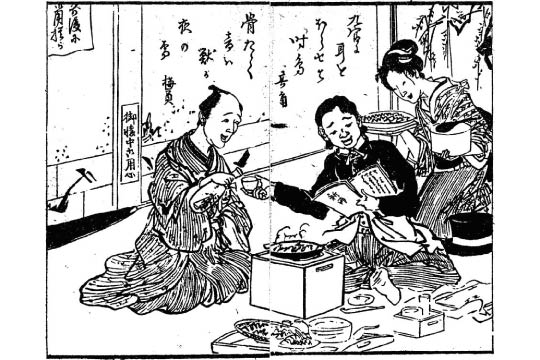
Which nabe dish do we have for tonight?
Hot pot has roughly three categories depending on the boldness of soup used for cooking. The first category uses water or light savory broth. This hot pot dish is accompanied by dipping sauces that complement the natural flavor of boiled or mildly seasoned ingredients in the pot. The most straightforward hot pot dish under this category is probably “Yudofu (湯豆腐),” consisting of tofu, boiling water, kelp, dipping sauce, and condiments. Yudofu is an uncomplicated and healthy hot pot allowing us to appreciate tofu. Shabu-shabu also falls under this category.
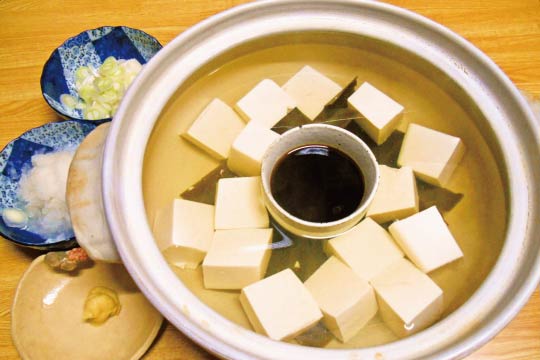
The second category uses distinctively flavored soup. Since the food gets cooked in bold-flavored soup stock containing miso or soy sauce, this type is not accompanied by dipping sauces. One of the most popular hot pot dishes, “Yosenabe (寄せ鍋),” containing popular ingredients such as fish, meat, vegetables, is under this category. “Oden (おでん),” another Japanese soul food, belongs to this category. We will talk about Oden in a separate posting.
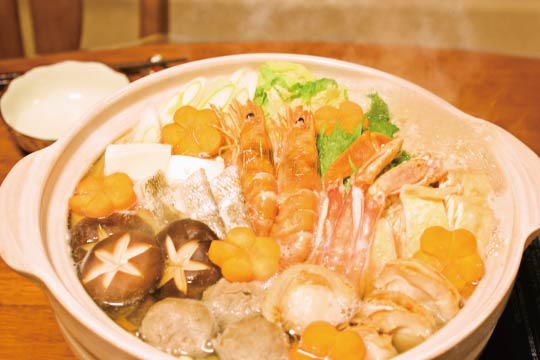
The third category uses a savory sauce containing solid flavors, such as miso or soy sauce boiled in a cast iron pot. Famous sukiyaki belongs to this type.
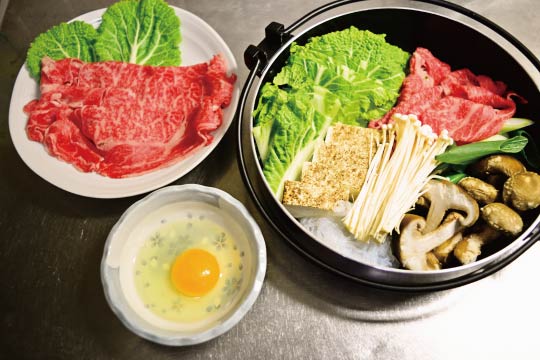
Hot pot dishes showcase full of regional flavors
Japan is an archipelago stretching from north to south and has many different terrains with various produce, livestock, and catch. Naturally, many hot pot recipes emerged to complement the local ingredients and climates. Here are some regional hot pot dishes loved by the locals.
"Ishikari nabe (石狩鍋)” - Hokkaido
Ishikari nabe features a miso-based soup with vegetables and salmon, a local catch from the Ishikari River. In a miso-based soup, a generous amount of vegetables, including onions, green onions, tofu, konjac, cabbage, are cooked with salmon fillets and scraps, which play a critical role to make a flavorful stock. Topping with sansho Japanese pepper is the authentic way to enjoy the dish.
"Kiritanpo nabe (きりたんぽ鍋)” - Akita prefecture
The dish is one of the best examples to showcase unique regional specialties, “Hinai jidori (比内地鶏)” and kiritanpo. Hinai jidori is a locally raised premium chicken used as an annual tribute to the government in the Edo period (19th century). Kiritanpo is half-smashed rice seasoned and toasted with soy or miso on a skewer. Maitake mushrooms and mitsuba (Japanese parsley) become accents to the ingredients. The flavor contrast between clean chicken stock seasoned with soy sauce and chewy kiritanpo is satisfying and enjoyable.
"Anko nabe (あんこう鍋)”- Ibaraki prefecture
Anko, anglerfish, has unappealing looks with a large head and a massive mouth with sharp teeth, but the taste is out of the world. Rich in collagen and low in fat, anglerfish is perfect for health-conscious epicureans. December through February are the best months as cold weather help anglerfish accumulate fat in their liver, a fish version of foie gras without cruelty. Because of its slimy body, anglerfish are challenging to handle on a cutting board; the fish are deboned being hung from its jaw on a hook called "tsurushigiri (吊るし切り)."
"Chanko nabe (ちゃんこ鍋)” - Tokyo
Although "chanko" refers to all the kinds of dishes prepared by sumo wrestlers, chanko nabe, hot pots have been the most popular dishes due to their superior nutritional value and ease of preparation. Each sumo stable takes pride in the house recipe. For centuries, sumo wrestlers have inherited a combination of ingredients and seasonings that made up the taste of their stables.
"Dote nabe (土手鍋)" - Hiroshima prefecture
The hot pot features miso paste mounted on the internal ring of a hot pot, which looks like a riverbank, called dote (土手) in Japanese. The miso gets gradually scraped down to season the soup while cooking vegetables and tofu with the main ingredient, oysters that are the famous regional specialty of Hiroshima prefecture."
"Motsu nabe (もつ鍋)" - Fukuoka prefecture
Fukuoka prefecture’s unique hot pot is an assortment of savory and bold flavors enjoyed in both the winters and summers with different purposes to get warm or to endure the summer heat. The main ingredient, cleaned beef offal, is simmered in bonito or kelp broth seasoned with soy sauce and miso paste accompanied by garlic, chives, cabbage, garlic, chives, and hot chili peppers.
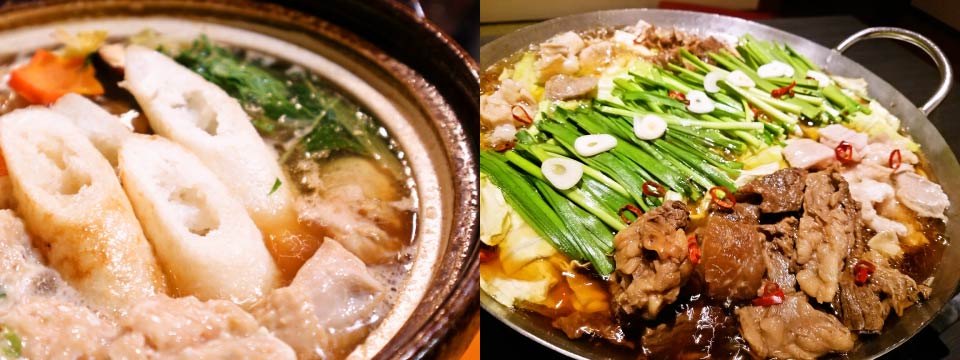
Last but not the least: "shime 〆"
The most enjoyable and unique thing about hot pots could be "shime 〆," a carbohydrate source served at the end of a hot pot meal, which is meant to utilize the soup with plenty of umami emanated from the vegetables, meat, and fish.
It is the authentic Japanese way to enjoy the goodness by allowing rice or noodles to soak it up until the last drop. The Japanese call this final step "shime (〆)," meaning "last" or "end," to announce the proper completion of a hot pot dish. Since porridge and noodles are so filling, they cause everyone an extra bulging stomach. However, it is strange that you feel something important is missing if you skip the shime.
What kind of ingredients do you use to make nabe and what kind of shime do you propose?
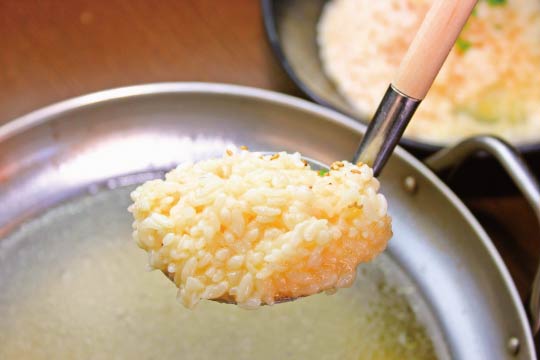
Did you find this blog interesting?
Please share it with your friends in the food service industry.
We regularly update the blog about the food culture of Japan, where TREHA® was discovered for culinary applications.
Click here and send us a message to subscribe.
Or hit us up on Instagram @trehalose_sensei!
You might also be interested in:

